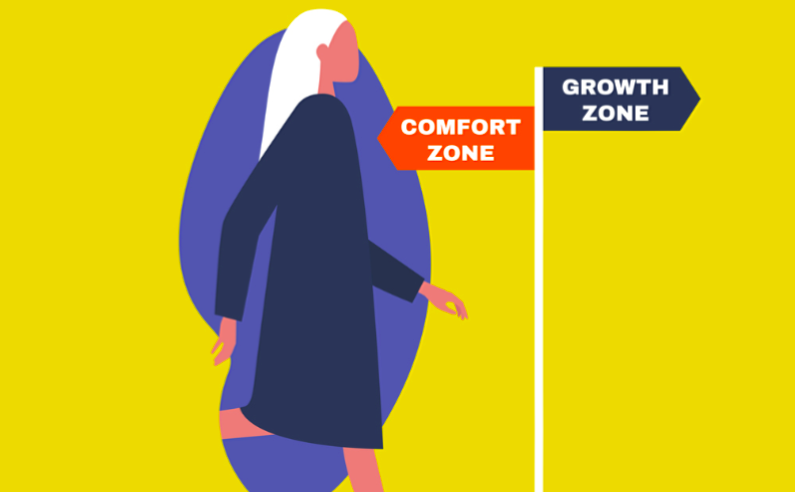We will survive this pandemic, but how will we survive it and what will we become afterwards? Will we be transformed by it? Will we be damaged by being unable to live up to our potential and change for the better? As human beings we naturally resist change – and that’s just small changes on a day-to-day basis. We shy away from anything outside our comfort zones and have actually become very good at it. Anything even vaguely inducing anxiety or discomfort becomes a reason for not doing it. Yet now we are faced with adapting to radical change, and that means possible anxiety and definite discomfort every day.
Change is inevitable. Change is constant.
– Benjamin Disraeli
We do have infinite capacity to be adaptable. It is hard-wired into us, but so often when we are faced with change we resist it – our default response to change, if you like, is to resist it. Yet we must be adaptable. We have to figure out how to roll with the punches right now. When explaining the best way to build adaptability, I always return to the idea of the comfort zone. It’s by leaving this zone and instead getting ourselves into the ‘stretch’ zone that we can build adaptability.
As the Covid-19 pandemic has developed, this situation will have put many people automatically into the ‘panic’ zone. This may not have happened immediately, but built over time as the daily news updates drip fed their nerves and became more alarming. When combined with their very real concerns about their businesses and livelihoods, it’s easy to see why those people might display an extreme resistance to change. They will have experienced a rollercoaster of different emotions, from denial to despair, to frustration, sadness and grief.
When faced with constant change and new information we can be left feeling stressed, overwhelmed, uncertain of what action to take, which in turn can lead to a lack of energy, motivation and drive as well as decision fatigue. The result can be that we are in a state of alert most of the time, which leads to stress and inaction. This will push us into panic zone but we don’t have to stay there – that is a choice.
Accepting our new reality
When we are in panic zone we resort to a fight or flight response. When we’re in ‘fight’ mode, we resort to behaviours like panic buying and stockpiling, which is all about survival. In ‘flight’ mode, we’re mostly in denial. We might spend time going down the rabbit hole of social media, buying into what other people say, and perhaps casting ourselves in the role of victim in this crisis.
None of this constitutes the comfort zone for anyone. Instead, what we all need to do is get ourselves into the ‘stretch’ zone, which is where we might feel uncomfortable and mildly anxious, but it is where we learn and grow.
To get there we have to accept the current reality of where we are. We might have to accept that we’re dealing with a business in danger of going bust, or with complex remote working arrangements, a loss of business or even having to completely reinvent our businesses. The sooner we can accept our current reality – even when that reality changes from day to day – the sooner we can act and adapt to this new reality.
We can achieve acceptance by moving into our stretch zone – this is where we can grow. To do this, we must focus on what we can control and take action every day. It doesn’t have to be much, but it does need to be consistent and tangible. When we start to do this we will begin to feel more in control and, most importantly, our comfort zone will expand.
The actions can be small – for example, researching the options open to your business; learning new skills to take elements of your business online; communicating and reaching out to clients and colleagues; choosing to do a Zoom call with your team each morning where you can see each other and talk to each other; limiting your news intake and being mindful over your choice of information sources; being more creative with your cookery skills; or finding new ways to home school your children.
As we adapt and grow, we step back into comfort zone. We can’t stay there – or stay in the panic zone – because no growth or learning will happen in either. It is by consistently stepping into the stretch zone and making our comfort zone bigger that we can start to adapt our lives, routines, businesses and work, and from there we can create exciting new opportunities. It is a journey – and one that I am on just as much as you are.
Interested in this topic? Read Disruption… leadership through change we didn’t create.
We will survive this pandemic, but how will we survive it and what will we become afterwards? Will we be transformed by it? Will we be damaged by being unable to live up to our potential and change for the better? As human beings we naturally resist change – and that’s just small changes on a day-to-day basis. We shy away from anything outside our comfort zones and have actually become very good at it. Anything even vaguely inducing anxiety or discomfort becomes a reason for not doing it. Yet now we are faced with adapting to radical change, and that means possible anxiety and definite discomfort every day.
Change is inevitable. Change is constant.
– Benjamin Disraeli
We do have infinite capacity to be adaptable. It is hard-wired into us, but so often when we are faced with change we resist it – our default response to change, if you like, is to resist it. Yet we must be adaptable. We have to figure out how to roll with the punches right now. When explaining the best way to build adaptability, I always return to the idea of the comfort zone. It’s by leaving this zone and instead getting ourselves into the ‘stretch’ zone that we can build adaptability.
As the Covid-19 pandemic has developed, this situation will have put many people automatically into the ‘panic’ zone. This may not have happened immediately, but built over time as the daily news updates drip fed their nerves and became more alarming. When combined with their very real concerns about their businesses and livelihoods, it’s easy to see why those people might display an extreme resistance to change. They will have experienced a rollercoaster of different emotions, from denial to despair, to frustration, sadness and grief.
When faced with constant change and new information we can be left feeling stressed, overwhelmed, uncertain of what action to take, which in turn can lead to a lack of energy, motivation and drive as well as decision fatigue. The result can be that we are in a state of alert most of the time, which leads to stress and inaction. This will push us into panic zone but we don’t have to stay there – that is a choice.
Accepting our new reality
When we are in panic zone we resort to a fight or flight response. When we’re in ‘fight’ mode, we resort to behaviours like panic buying and stockpiling, which is all about survival. In ‘flight’ mode, we’re mostly in denial. We might spend time going down the rabbit hole of social media, buying into what other people say, and perhaps casting ourselves in the role of victim in this crisis.
None of this constitutes the comfort zone for anyone. Instead, what we all need to do is get ourselves into the ‘stretch’ zone, which is where we might feel uncomfortable and mildly anxious, but it is where we learn and grow.
To get there we have to accept the current reality of where we are. We might have to accept that we’re dealing with a business in danger of going bust, or with complex remote working arrangements, a loss of business or even having to completely reinvent our businesses. The sooner we can accept our current reality – even when that reality changes from day to day – the sooner we can act and adapt to this new reality.
We can achieve acceptance by moving into our stretch zone – this is where we can grow. To do this, we must focus on what we can control and take action every day. It doesn’t have to be much, but it does need to be consistent and tangible. When we start to do this we will begin to feel more in control and, most importantly, our comfort zone will expand.
The actions can be small – for example, researching the options open to your business; learning new skills to take elements of your business online; communicating and reaching out to clients and colleagues; choosing to do a Zoom call with your team each morning where you can see each other and talk to each other; limiting your news intake and being mindful over your choice of information sources; being more creative with your cookery skills; or finding new ways to home school your children.
As we adapt and grow, we step back into comfort zone. We can’t stay there – or stay in the panic zone – because no growth or learning will happen in either. It is by consistently stepping into the stretch zone and making our comfort zone bigger that we can start to adapt our lives, routines, businesses and work, and from there we can create exciting new opportunities. It is a journey – and one that I am on just as much as you are.
Interested in this topic? Read Disruption… leadership through change we didn’t create.









